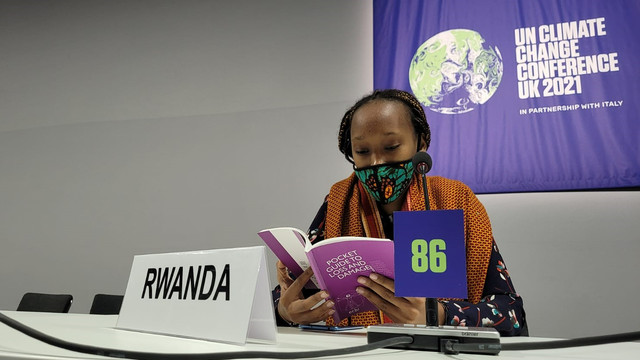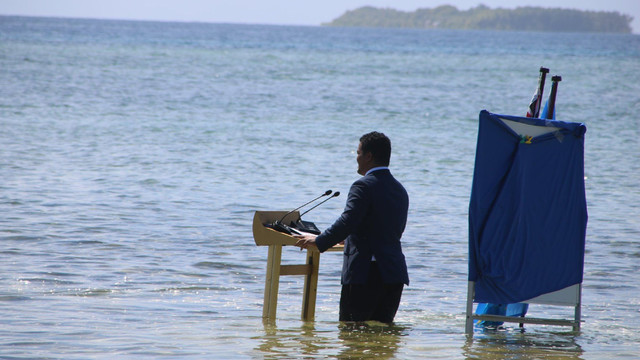Local must lead action to tackle world’s multiple interconnected challenges
Sam Greene distils key messages drawn from lively online dialogue with the 500-plus participants from over 70 countries who joined the 14th International Conference on Community-based Adaptation to climate change.


This year, the 14th International Conference on Community-based Adaptation took place online, resulting in a participatory, global and solution-focused event on how to address the most pressing challenges facing climate vulnerable people in the global South (Image: IIED)
Across the globe we have witnessed the ravages of COVID-19 unfold, upending the global economy and claiming over a million lives. Meanwhile, climate devastation has continued – from wildfires raging in California, to deadly floods in Yemen, to super-cyclone Amphan leaving a third of Bangladesh underwater.
Threats to biodiversity continue apace; a recent study highlighted that, without urgent action, biodiversity loss will soon irreversibly harm future generations.
The pandemic, climate change and biodiversity loss are intertwined with rising inequality – each disproportionately affecting the most vulnerable. And these crises show that the multiple risks faced by vulnerable communities do not fall neatly into separate categories.
Policymakers must recognise that these global challenges are interlinked. Several high-profile events in the coming months present the opportunity to set higher ambitions for responding to these challenges.
The Climate Adaptation Summit in January will be the culmination of the Global Commission on Adaptation's Year of Action. Heads of state will set deeper commitments to build resilience and encourage global dialogue on what works.
The UN Convention on Biological Diversity (CBD COP15) – planned for May – will seek to agree a new global framework to stop the rapid loss of the world’s biodiversity.
At the delayed UN climate change summit (COP26) in Glasgow, countries will be under pressure to increase the ambition of their climate action plans (Nationally Determined Contributions) to bring the climate crisis under control and to set new long-term climate finance targets.
For these policies and frameworks to be successful, decision makers must recognise the interdependent nature of the global challenges we face.
They must also ensure these policies and frameworks are grounded in real world contexts.
Local must lead
For over 16 years, the community-based adaptation (CBA) community of practice has been making the case for locally led action on climate change.
This year CBA14 went online creating a truly participatory global event, generating lively and innovative solution-focused dialogue on how to tackle the most pressing and complex challenges facing climate vulnerable people in the global South.
From more than 30 sessions over five days common messages quickly emerged:
‘Business unusual’
Local communities are constantly multi-tasking to build resilience to a range of complex risks – relating not only to climate change but to other known and unknown risks.
We must adopt new ways to understand this ‘multi-dimensional’ resilience. Local actors including governments, community-based organisations and small and medium-sized enterprises must be central in articulating what it looks like and how to develop it across diverse and varied contexts.
Holistic local responses that recognise local priorities and intra-community differences are critical to transformation. Many communities have decades of practical experience working with their environment using Indigenous and traditional knowledge, and through informal and customary institutions.
This knowledge and experience must be systematically integrated into policymaking processes so it can be acted on. This will enable governments to link this knowledge to scientific research and understand the policies needed for it to be effective.
Nature-based solutions can link the challenges of climate change, biodiversity loss and poverty, and are key to a holistic response. Communities are successfully deploying these solutions to adapt to climate change in both rural and urban environments.
Not only are these solutions accessible to communities, evidence shows they can be cost effective while creating livelihood opportunities. But to reap these benefits, communities must have tenure rights, so they can claim and retain their assets and shape the solutions themselves.
CBA14 highlighted how communities can have greater power in numbers when they connect with each other and national actors.
Practitioners called on international NGOs and multilateral agencies to use their convening power to establish platforms and broker more equitable community participation in policymaking and programme decision-making. Their experience has shown that governments trust communities’ abilities to lead, once they have demonstrated their knowledge in practice.
Such platforms enable horizontal communication across like-minded actors but also vertical – sharing local knowledge with policymakers while creating avenues for those same policymakers to engage directly with local people and be held accountable.
Thinking long term
CBA14 called for development partners to make longer commitments – solutions that address complex, context specific challenges cannot be developed quickly. It takes time to build and embed institutional capacities in countries where these solutions are needed most.
This requires local organisations to adapt, learn from mistakes, build partnerships and innovate. Development contributors and investors – both public and private – need to provide longer term investment to make this happen.
Development partners, meanwhile, need – as one participant put it – to “get comfortable with being uncomfortable”, that is lean into the risks of working long term and locally. The development community needs to create incentives so that generating learning and insight is considered a success alongside traditionally quantifiable results.
CBA14 called for investment in tomorrow’s leaders. Working towards long-term goals must recognise the leadership of young people and women. Both groups continue to be marginalised from high-level decision-making processes – when young people and particularly Indigenous women are included, it is often as tokens to represent diverse perspectives, or as volunteers rather than equal participants.
Both young people and women play important roles in their communities preparing for future disasters, sharing climate information and protecting children. Yet they continue to be limited by long-standing cultural and institutional barriers and lack of access to knowledge and skills.
Universities in the least developed countries have an important role in building the capacities of young people – the foundations for a generation of experts equipped to shape institutions that are ready for an uncertain future.
Building back
2020 was set to be a crunch year for climate action. Now, the added challenge of COVID-19 is forcing international processes to adapt and evolve while recognising the complexity of multiple risks and threats facing vulnerable and marginalised communities.
As the pandemic persists, local communities, organisations and networks continue, through bottom-up decision-making and proven capacity to self-organise, to respond dynamically.
Coupled with an emerging rhetoric to ’build back better’, in the coming months we have an opportunity to build the innovation, knowledge and experience of local actors into efforts to tackle the world’s evolving and interlinking challenges – in their many and complex forms.
- Download the collated knowledge and experiences from CBA14
- Watch full video recordings of all the sessions from CBA14 in a playlist on IIED's YouTube channel




